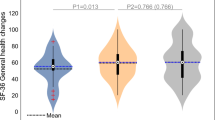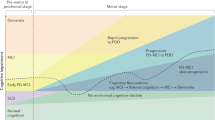Abstract
Study design
Using a cross-sectional design, we extracted sociodemographic and clinical data from 488 Spinal Cord Injury (SCI) patients during their initial assessment before receiving intensive rehabilitation treatment.
Objectives
The primary objectives of this study were to ascertain the prevalence of cognitive impairment in the study sample and specify the key clinical and demographic predictors of cognitive functioning in SCI patients.
Setting
Lucy Montoro Rehabilitation Institute (LMRI), University of Sao Paulo, Sao Paulo, Brazil.
Methods
We utilized independent univariate and multivariate regression models with the Montreal Cognitive Assessment (MoCA) scale, adapted for individuals with visual impairment. Moreover, we consider scores from the execution tasks (visuospatial/executive) as the dependent variable.
Results
Our findings demonstrate that approximately 80% of the evaluated study sample exhibited cognitive impairment. Through the multivariate regression models, we show that several factors, including age, education, depression levels, and the use of analgesics and/or opioids, are significant predictors of total cognitive scores. These factors are independent of the clinical features associated with SCI, such as age, sex, education, and time since the injury.
Conclusions
The results indicate a high prevalence of significant cognitive impairment within the sample, with age, education, depression levels, and the use of analgesics and/or opioids emerging as the primary predictors of total cognitive scores, independent of the clinical features correlated to SCI. These findings hold significant implications for both clinical research and practice, offering valuable guidance for comprehensive management throughout hospitalization and rehabilitation.
This is a preview of subscription content, access via your institution
Access options
Subscribe to this journal
Receive 12 print issues and online access
$259.00 per year
only $21.58 per issue
Buy this article
- Purchase on Springer Link
- Instant access to full article PDF
Prices may be subject to local taxes which are calculated during checkout

Similar content being viewed by others
Data availability
This work correspondence and requests for materials should be addressed to Marcel Simis.
References
Alcántar-Garibay OV, Incontri-Abraham D, Ibarra A. Spinal cord injury-induced cognitive impairment: a narrative review. Neural Regen Res. 2022;17:2649–54. https://doi.org/10.4103/1673-5374.339475.
Noller CM, Groah SL, Nash MS. Inflammatory stress effects on health and function after spinal cord injury. Top Spinal Cord Inj Rehabil. 2017;23:207–17. https://doi.org/10.1310/sci2303-207.
Ankeny DP, Guan Z, Popovich PG. B cells produce pathogenic antibodies and impair recovery after spinal cord injury in mice. J Clin Investig. 2009;119:2990–9. https://doi.org/10.1172/JCI39780.
Wecht JM, Weir JP, Katzelnick CG, Wylie G, Eraifej M, Nguyen N, et al. Systemic and cerebral hemodynamic contribution to cognitive performance in spinal cord injury. J Neurotrauma. 2018;35:2957–64. https://doi.org/10.1089/neu.2018.5760.
Craig A, Guest R, Tran Y, Middleton J. Cognitive impairment and mood states after spinal cord injury. J Neurotrauma. 2017;34:1156–63. https://doi.org/10.1089/neu.2016.4632.
Molina B, Segura A, Serrano JP, Alonso FJ, Molina L, Pérez-Borrego YA, et al. Cognitive performance of people with traumatic spinal cord injury: a cross-sectional study comparing people with subacute and chronic injuries. Spinal Cord. 2018;56:796–805. https://doi.org/10.1038/s41393-018-0076-0.
Ding W, Hu S, Wang P, Kang H, Peng R, Dong Y, et al. Spinal cord injury: the global incidence, prevalence, and disability from the global burden of disease Study 2019. Spine. 2022;47:1532–40. https://doi.org/10.1097/BRS.0000000000004417.
Williams R, Murray A. Prevalence of depression after spinal cord injury: a meta-analysis. Arch Phys Med Rehabil. 2015;96:133–40. https://doi.org/10.1016/j.apmr.2014.08.016.
Le J, Dorstyn D. Anxiety prevalence following spinal cord injury: a meta-analysis. Spinal Cord. 2016;54:570–8. https://doi.org/10.1038/sc.2016.15.
Otis C, Marchand A, Courtois F. Risk factors for post-traumatic stress disorder in persons with spinal cord injury. Top Spinal Cord Inj Rehabil. 2012;18:253–63. https://doi.org/10.1310/sci1803-253.
Sachdeva R, Gao F, Chan CCH, Krassioukov AV. Cognitive function after spinal cord injury: a systematic review. Neurology. 2018;91:611–21. https://doi.org/10.1212/WNL.0000000000006244.
Davidoff GN, Roth EJ, Richards JS. Cognitive deficits in spinal cord injury: epidemiology and outcome. Arch Phys Med Rehabil. 1992;73:275–84.
Dawes P, Pye A, Reeves D, Yeung WK, Sheikh S, Thodi C, et al. Protocol for the development of versions of the Montreal Cognitive Assessment (MoCA) for people with hearing or vision impairment. BMJ Open. 2019;9:e026246 https://doi.org/10.1136/bmjopen-2018-026246.
Nasreddine ZS, Phillips NA, Bédirian V, Charbonneau S, Whitehead V, Collin I, et al. The Montreal Cognitive Assessment, MoCA: a brief screening tool for mild cognitive impairment. J Am Geriatr Soc. 2005;53:695–9. https://doi.org/10.1111/j.1532-5415.2005.53221.x.
Daniel B, Agenagnew L, Workicho A, Abera M. Psychometric Properties of the Montreal Cognitive Assessment (MoCA) to Detect Major Neurocognitive Disorder Among Older People in Ethiopia: A Validation Study. Neuropsychiatr Dis Treat. 2022;18:1789–98. https://doi.org/10.2147/NDT.S377430.
Gülke E, Alsalem M, Kirsten M, Vettorazzi E, Choe CU, Hidding U, et al. Comparison of Montreal cognitive assessment and Mattis dementia rating scale in the preoperative evaluation of subthalamic stimulation in Parkinson’s disease. PLoS One. 2022;17:e0265314 https://doi.org/10.1371/journal.pone.0265314.
Roalf DR, Moore TM, Wolk DA, Arnold SE, Mechanic-Hamilton D, Rick J, et al. Defining and validating a short form Montreal Cognitive Assessment (s-MoCA) for use in neurodegenerative disease. J Neurol Neurosurg Psychiatry. 2016;87:1303–10. https://doi.org/10.1136/jnnp-2015-312723.
Song CS, Lee HS, Chun BY. Comparison of Montreal Cognitive Assessment in Korean Version for Predicting Mild Cognitive Assessment in 65-Year and Over Individuals. Occup Ther Int. 2022;2022:4108434 https://doi.org/10.1155/2022/4108434.
Pirani A, Nasreddine Z, Neviani F, Fabbo A, Rocchi MB, Bertolotti M, et al. MoCA 7.1: Multicenter Validation of the First Italian Version of Montreal Cognitive Assessment. J Alzheimers Dis Rep. 2022;6:509–20. https://doi.org/10.3233/ADR-210053.
Katz MJ, Wang C, Nester CO, Derby CA, Zimmerman ME, Lipton RB, et al. T-MoCA: A valid phone screen for cognitive impairment in diverse community samples. Alzheimers Dement (Amst). 2021;13:e12144 https://doi.org/10.1002/dad2.12144.
Jammula V, Rogers JL, Vera E, Christ A, Leeper HE, Acquaye A, et al. The Montreal Cognitive Assessment (MoCA) in neuro-oncology: A pilot study of feasibility and utility in telehealth and in-person clinical assessments. Neurooncol Pract. 2022;9:429–440 https://doi.org/10.1093/nop/npac038.
Binoy S, Monstaser-Kouhsari L, Ponger P, Saban W. Remote assessment of cognition in Parkinson’s disease and Cerebellar Ataxia: the MoCA test in English and Hebrew. Front Hum Neurosci. 2024;17:1325215 https://doi.org/10.3389/fnhum.2023.1325215.
Carvalho CM, de Andrade KR, Poltronieri BC, et al. Translation and validation of the audiovisual version of the Montreal cognitive assessment in older adults in Brazil. BMC Geriatr. 2024;24:10 https://0-doiorg.brum.beds.ac.uk/10.1186/s12877-023-04553-2
Zigmond AS, Snaith RP. The hospital anxiety and depression scale. Acta Psychiatr Scand. 1983;67:361–70. https://doi.org/10.1111/j.1600-0447.1983.tb09716.x.
Roberts TT, Leonard GR, Cepela DJ. Classifications In Brief: American Spinal Injury Association (ASIA) Impairment Scale. Clin Orthop Relat Res. 2017;475:1499–504. https://doi.org/10.1007/s11999-016-5133-4
Hara ACP, Aching NC, Marques LM, Fregni F, Battisttella LR, Simis M. Clinical and demographic predictors of symptoms of depression and anxiety in patients with spinal cord injury. Spinal Cord. 2022;60:1123–9. https://doi.org/10.1038/s41393-022-00831-9.
Marino RJ, Barros T, Biering-Sorensen F, Burns SP, Donovan WH, Graves DE, et al. International standards for neurological classification of spinal cord injury. J Spinal Cord Med. 2003;26:S50–6. https://doi.org/10.1080/10790268.2003.11754575. Suppl 1
Hocking RR. A biometrics invited paper. the analysis and selection of variables in linear regression. Biometrics. 1976;32:1 https://doi.org/10.2307/2529336.
Ernst AF, Albers CJ. Regression assumptions in clinical psychology research practice-a systematic review of common misconceptions. PeerJ. 2017;5:e3323 https://doi.org/10.7717/peerj.3323
Chiaravalloti ND, Weber E, Wylie G, Dyson-Hudson T, Wecht JM. The impact of level of injury on patterns of cognitive dysfunction in individuals with spinal cord injury. J Spinal Cord Med. 2020;43:633–41. https://doi.org/10.1080/10790268.2019.1696076.
Chiaravalloti ND, Weber E, Wylie G, Dyson-Hudson T, Wecht JM. Patterns of cognitive deficits in persons with spinal cord injury as compared with both age-matched and older individuals without spinal cord injury. J Spinal Cord Med. 2020;43:88–97. https://doi.org/10.1080/10790268.2018.1543103.
Murray RF, Asghari A, Egorov DD, Rutkowski SB, Siddall PJ, Soden RJ, et al. Impact of spinal cord injury on self-perceived pre- and postmorbid cognitive, emotional and physical functioning. Spinal Cord. 2007;45:429–36. https://doi.org/10.1038/sj.sc.3102022.
Lenehan ME, Summers MJ, Saunders NL, Summers JJ, Vickers JC. Relationship between education and age-related cognitive decline: a review of recent research. Psychogeriatrics. 2015;15:154–62. https://doi.org/10.1111/psyg.12083.
Mantri S, Nwadiogbu C, Fitts W, Dahodwala N. Quality of education impacts late-life cognition. Int J Geriatr Psychiatry. 2019;34:855–62. https://doi.org/10.1002/gps.5075.
Handing EP, Hayden KM, Leng XI, Kritchevsky SB. Predictors of cognitive and physical decline: results from the health aging and body composition study. Front Aging Neurosci. 2023;15:1122421 https://doi.org/10.3389/fnagi.2023.1122421.
Parker MA, Ichikawa JK, Bombardier CH, Hammond FM. Association between anxiety symptoms, depression symptoms, and life satisfaction among individuals 1 year after spinal cord injury: findings from the SCIRehab project. Arch Rehabil Res Clin Transl. 2022;4:100211 https://doi.org/10.1016/j.arrct.2022.100211.
Bonanno GA, Kennedy P, Galatzer-Levy IR, Lude P, Elfström ML. Trajectories of resilience, depression, and anxiety following spinal cord injury. Rehabil Psychol. 2012;57:236–47. https://doi.org/10.1037/a0029256.
Distel DF, Amodeo M, Joshi S, Abramoff BA. Cognitive dysfunction in persons with chronic spinal cord injuries. Phys Med Rehabil Clin N. Am. 2020;31:345–68. https://doi.org/10.1016/j.pmr.2020.04.001.
Dillon DG, Pizzagalli DA. Mechanisms of memory disruption in depression. Trends Neurosci. 2018;41:137–49. https://doi.org/10.1016/j.tins.2017.12.006.
Polich G, Iaccarino MA, Zafonte R. Psychopharmacology of traumatic brain injury. Handb Clin Neurol. 2019;165:253–67. https://doi.org/10.1016/B978-0-444-64012-3.00015-0
Kushner DS, Alvarez G. Dual diagnosis: traumatic brain injury with spinal cord injury. Phys Med Rehabil Clin N Am. 2014;25:681–96. https://doi.org/10.1016/j.pmr.2014.04.005.
Del Ser T, Zea MA, Valentí M, Olazarán J, López-Álvarez J, Rebollo-Vázquez A, et al. Effects of commonly prescribed drugs on cognition and mild cognitive impairment in healthy elderly people. J Psychopharmacol. 2019;33:965–74. https://doi.org/10.1177/0269881119857206.
Pask S, Dell’Olio M, Murtagh FEM, Boland JW. The effects of opioids on cognition in older adults with cancer and chronic noncancer pain: a systematic review. J Pain Symptom Manag. 2020;59:871–893.e1. https://doi.org/10.1016/j.jpainsymman.2019.10.022.
Carlozzi NE, Graves CM, Troost JP, Ehde DM, Miner JA, Kratz AL. Association of physical and mental symptoms with cognition in people with spinal cord injury. Rehabil Psychol. 2021;66:532–40. https://doi.org/10.1037/rep0000416.
Acknowledgements
Authors are grateful to Margarida H. Miyazaki, executive director of IMREA; Fabio Pacheco Muniz de Souza e Castro, executive director of LMRI; Katia Lina Miyahara and Mariane Tateishi, Clinical Director of IMREA, for the tremendous support of the hospital. Besides, Vera Lucia Rodrigues Alves, Valéria Dini Leite, Daniel Rubio de Souza, and Artur César Aquino dos Santos for assistance with study monitoring.
Funding
This work was supported by Núcleo de Apoio a Pesquisa-Núcleo de Estudos Avançados em Reabilitação (NAP-NEAR). The researchers received support from the São Paulo Research Foundation (FAPESP- SPEC, grant #17/12943-8). Specifically, LMM was supported by a postdoctoral research grant #21/05897-5, São Paulo Research Foundation (FAPESP), SPB is supported by a postdoctoral research grant #20/08512-4, São Paulo Research Foundation (FAPESP).
Author information
Authors and Affiliations
Contributions
Simis, M. and Battistella, L.R. developed the study concept and design. Moreover, Portela-Hara, A.C. and Aching, NC, performed data collection. Marques, L.M. performed the data analysis. All authors participated in the interpretation of the results, the writing of the manuscript, and the approval of its final version.
Corresponding author
Ethics declarations
Competing interests
The authors declare no competing interests.
Ethical approval
This study was submitted and approved by the Ethics Committee for Analysis of Research Projects - CAPPesq of the Clinical Hospital of the Faculty of Medicine of USP (N°. Plataforma Brasil 15138519.0000.0068).
Additional information
Publisher’s note Springer Nature remains neutral with regard to jurisdictional claims in published maps and institutional affiliations.
Supplementary information
Rights and permissions
Springer Nature or its licensor (e.g. a society or other partner) holds exclusive rights to this article under a publishing agreement with the author(s) or other rightsholder(s); author self-archiving of the accepted manuscript version of this article is solely governed by the terms of such publishing agreement and applicable law.
About this article
Cite this article
Portela Hara, A.C., Aching, N.C., Marques, L.M. et al. The role of clinical and demographic predictors for understanding the cognitive impairment in Spinal Cord Injury (SCI) patients. Spinal Cord (2024). https://doi.org/10.1038/s41393-024-00986-7
Received:
Revised:
Accepted:
Published:
DOI: https://doi.org/10.1038/s41393-024-00986-7



